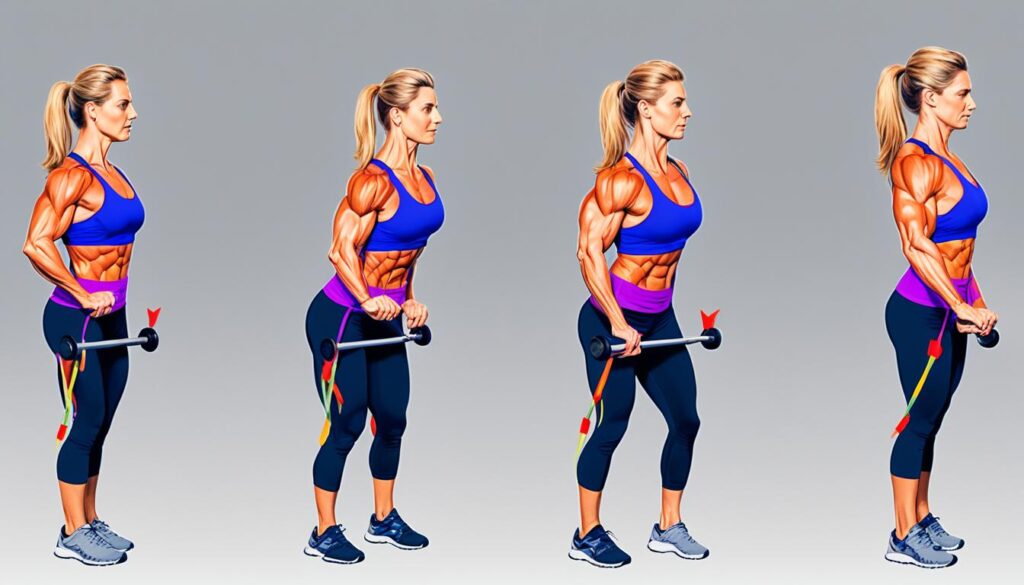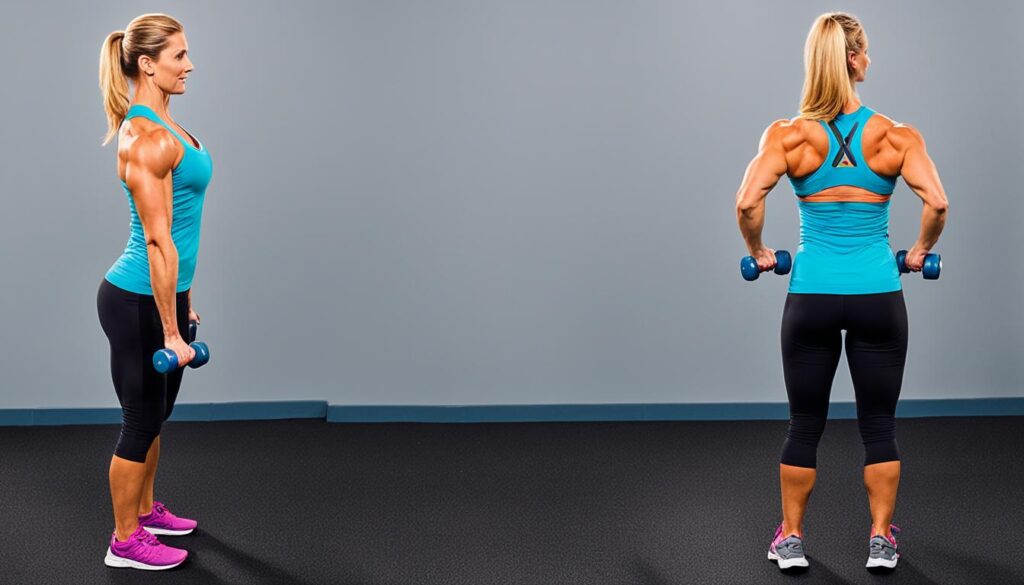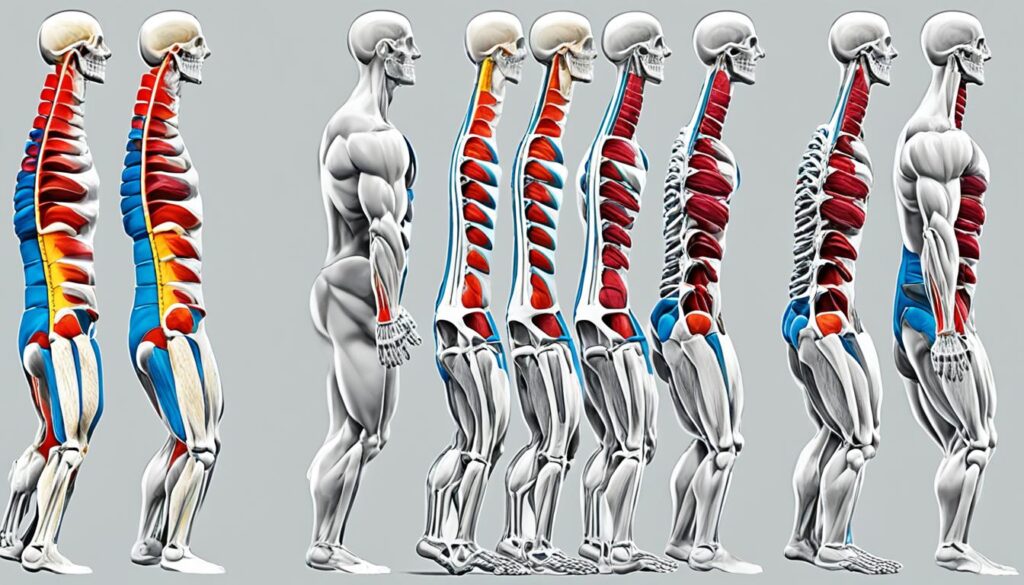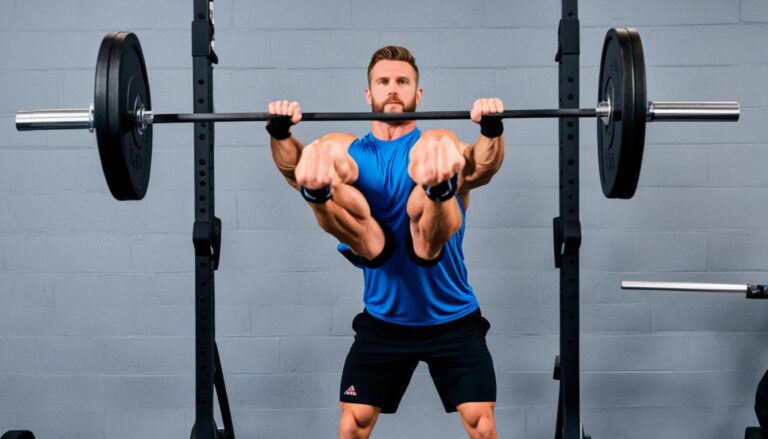Welcome to our detailed guide on the bent-over row! This exercise is great for anyone, from new lifters to pros. It focuses on your upper body, especially your back and arms. Knowing how to do it right boosts your back workout and fitness level hugely. As part of the “pull family,” alongside pull-downs and pull-ups, it works wonders for your postural stability and muscle growth. Thus, it’s a key part of any solid strength training plan.
Key Takeaways:
- The bent-over row is a powerful exercise for building postural stability, back strength, and back hypertrophy.
- It is part of the “pull family” of exercises, focusing on back and arm dominant movements.
- Proper set-up involves a hip hinge, neutral spine, stable core, and proper hand position.
- Tension in the body is crucial for optimal row performance.
- Stability checkpoints include creating tension in the feet, driving knees laterally, maintaining a neutral spine, tightening abdominals, and pulling shoulder blades down and back.
- Movement should be primarily focused on the elbow and shoulder joints, while the rest of the body remains stable for “proximal stability and distal mobility.”
- The bent-over row primarily targets the Latissimus Dorsi, Rhomboids, Spinal Erectors, and Trapezius muscles.
- Grip variations and hand positioning can engage additional muscle groups such as the biceps, forearms, hamstrings, glutes, and rear deltoids.
- Proper form in the bent-over row exercise helps prevent injuries and increases metabolic rate.
- There are various types of bent-over row techniques, including the Pendlay Row, Yates Row, Dumbbell Row, T-Bar Row, Helms Row, and Barbell Dead Row.
Benefits of Bent-Over Row
The bent-over row is great for making your back strong. It also helps build muscles and keep you stable. By doing this exercise, you get lots of benefits for your fitness journey.
1. Muscle Building and Strength
This exercise is not just for your back. It works out your latissimus dorsi, rhomboids, trapezius, and erector spinae too. Building these muscles helps your back stay strong for daily activities.
It doesn’t just work your upper back. The whole back gets stronger. This is why it’s seen as a key move for a powerful back.
2. Posture Improvement
Bent-over rows help fix bad posture. They strengthen your upper back, fighting against hunched shoulders and bad desk posture.
Doing them right makes your upper body feel balanced. It stops bad posture and helps you stand up straight and strong.
3. Functional Fitness Enhancement
Yes, it makes you stronger. But it also helps with how well your body moves. By working the upper back, you get better balance, coordination, and overall strength.
This means you do better in sports and daily life. It makes your body work well and feel strong.
4. Versatility and Accessibility
The bent-over row is for everyone. Beginners can start light and work on form. As they get better, they can add more weight.
Advanced folks can try different row types. This keeps the back muscles guessing and growing. It’s always a challenge.
5. Comprehensive Back Engagement
This exercise is great for the upper and middle back. It really targets those muscle groups. That’s why your back feels so strong after.
Your back will look and feel balanced. This exercise makes sure all those muscles get a good workout.
| Recommended Sets and Reps | Exercise Variation | Primary Muscle Groups |
|---|---|---|
| 4-6 sets of 6-12 reps | Bent-Over Row with Barbell | Upper and Middle Back |
| 3-5 sets of 5 reps | Bent-Over Row with Barbell (for beginners) | Upper and Middle Back |
Use heavy weights for this exercise. This grows your muscles and makes you strong. Hold the barbell with hands wider than shoulders to really work the back.
Always focus on how you do the exercise. This is more important than lifting super heavy. Add more weight as you get better. Also, get advice from a pro to match this exercise to your goals.
Set-Up for Bent-Over Row
Setting up the bent-over row correctly is vital. Doing it right ensures your body is safe and the exercise is effective. There are several important steps to follow.
1. Hip Hinge
Start by standing with feet shoulder-width apart and bent knees. Then, hinge at your hips. Push your butt back while keeping your back straight. This position helps your back and upper body muscles work well.
2. Neutral Spine
Keep the hip hinge and focus on your spine. Keep it straight, not rounded or arched. A straight spine spreads the weight well, saving your lower back from harm.
3. Stable Core
Your core must be tight for stable and correct exercise form. It builds a strong base and protects your spine. Pull your belly button in towards your spine to engage your deep core.
4. Hand Position and Grip Width
Find a hand position that feels good and works your muscles well. You can use an overhand or underhand grip. Try both to see which one suits you best.
Keep your hands a bit wider than your shoulders. This width helps with stability. It also lets your elbows move freely without hurting your joints. Now, you’re all set for the bent-over row.
Remember to keep your form in check, fire up those target muscles, and tune in to what your body is telling you. This way, you avoid pains and injuries.
Technique for Bent-Over Row
The bent-over row is great for your back and posture. It builds stability and strength. To get the most out of it, you need to do it right. Here are the key things to focus on.
Stability in Elbow and Shoulder Joints
Keeping your elbows and shoulders stable is key in a bent-over row. This stops too much movement, so your muscles work as they should. Only your elbows and shoulders should move. Your spine and shoulder blade joints need to stay still.
Pull and Bar Position
Focus on pulling your elbows up to the ceiling in a bent-over row. This activates your back muscles well. The bar should be close to your legs as you move. This makes sure your body is in the right position for the best muscle work.
Core Stability
A steady core is important in a bent-over row. It lets your arm and back muscles push and pull effectively. Keep your abs tight and back straight. This helps your core stay strong during the exercise.
Cues for Proper Form
There are cues to help you do the row with proper form. Focus on keeping your elbows behind you. Squeeze your back muscles when pulling up. Imagine the movement is all from your back. This thinking boosts muscle use and your workout results.
Scientific Background
Studies have looked at how different rowing exercises affect your back muscles and spine. The bent-over row has been shown to be very effective. It helps us make sure we’re working the right muscles. This moves us closer to our fitness aims.
These tips can help you do the bent-over row correctly. They make sure you have the best form, motion, and strength. Adding this exercise to your routine is a smart move. It helps you get a stronger back and a more balanced body shape.
Ascent and Descent in Bent-Over Row
Focusing on how you go up and down is key in getting the most from the bent-over row. When going up, concentrate on using your back muscles, especially the lats. This ensures you’re activating the right muscles. It also builds strength in your back and helps keep your posture in check.
When you’re pulling the weight up, make sure your elbows and shoulders are doing the work. Keep the rest of your body, like your spine and shoulder blades, stable. This concept, called “proximal stability and distal mobility,” means you’re moving rightly and staying in the best form.
Going back down, watch out for bad habits that hurt your form. Try not to let your shoulders roll forward or elbows stick out wide. Instead, focus on keeping your elbows back, aimed behind you. This keeps your form correct and your muscles working as hard as they should.
A study by Fenwick and others in 2009 looked at various rowing moves, highlighting how staying stable and activating the right muscles is vital in the bent-over row. By sticking to these tips, you can nail both the up and down parts of the exercise. This promises better results in your back workouts.

Importance of Core Stability in Bent-Over Row
Core stability is key for the bent-over row. It helps keep your spine aligned right and your body steady. This makes your core muscles stand out and keeps your hips from moving too much.
Working on your core while rowing helps you use your back and arm muscles better. It makes sure these muscles are pulling their weight during the exercise.
To do better at this row, focus on a few things:
- Push your feet down to keep your body still.
- Push your knees out to really work your core and stand firm.
- Keep your back straight by not letting it round too much or arch.
- Suck in your belly to hold your core steady.
- Lower and pull your shoulder blades back to keep a good posture.
By sticking to these steps, you get your core to do what it should. It works together well with your back and arms, making the row work best and keeping you safe.
Always remember: Doing it right means protecting your joints, getting stronger, and just being more body smart.
| Muscles Targeted | Benefits |
|---|---|
| Lats (Latissimus Dorsi) | Increased muscle-building benefits |
| Trapezius and Rhomboids | Improved posture and prevention of slouched, rounded shoulders |
| Posterior Deltoids | Assistance in rowing the weight and pulling shoulder blades together and back |
| Biceps | Assist the rowing movement as secondary movers |
| Erector Spinae | Stabilization of the spine in the hinged bent-over position |
| Transverse Abdominis | Stabilization of the core and minimization of lower back injuries |
Optimizing Stability in Bent-Over Row
Staying stable in a bent-over row is key for good form and getting the most out of it. You need to concentrate on your feet, keep your back muscles tight, and position your shoulder blades correctly. This way, you stay safe and see better results.
When it comes to staying steady, how you use your feet matters a lot. Pushing down with your toes helps you stand strong. It also helps your leg muscles work, keeping you from wobbling.
Focusing on the muscles in your back is a big deal too. The lats are major players in a bent-over row. If you tighten them up, you make sure every part of the row is working like it should. This keeps you steady and helps prevent injuries.
Don’t forget about your shoulder blades. They need to be pulled back and down. This locks your upper body in place and keeps your spine straight. Being in this proper setup means better muscle work and less chance of hurting yourself.
To do bent-over rows right, keep these points in mind. Squeeze the floor with your toes, really feel your back muscles, and adjust your shoulder blades. These simple moves help make your workout both effective and safe.
| Key Points for Optimizing Stability: | Benefits: |
|---|---|
| Create tension in the feet | – Increased stability |
| Engage and maintain tension in the lats | – Proper muscle activation |
| Pull the shoulder blades down and back | – Reduced risk of injury |
Common Mistakes in Bent-Over Row
To make sure you’re getting the most out of bent-over rows, it’s vital to steer clear of these mistakes. By understanding what to avoid, you can focus on the right form and technique. Let’s look at two key errors and the best way to fix them.
Common Mistake 1: Picking weights that are too heavy
Many make the mistake of choosing weights that are way too heavy for them. When you do this, your biceps end up doing most of the work. It’s crucial to pick weights that let you keep good form and really work your back.
Solution 1: First, try the exercise without any weights. Concentrate on squeezing your shoulder blades together. This gets your back muscles working.
Once you’ve got this down, move to light dumbbells. Focus on pulling them to your pockets or lower ribs. This will maintain proper form and target your back effectively.
Common Mistake 2: Pulling the weight too high up
Pulling the weight too high up is another mistake. Rather than pulling it towards you, it goes too high. This can mess with your shoulders and make the exercise less useful.
Solution 2: Work on pulling the weights lower, towards your lower ribs. Keep this area in mind instead of going too high. It keeps your shoulders in a better spot and makes sure your back is really working.
Avoiding these errors and following the solutions can make your bent-over rows better. This will improve your back workout and get you more out of the exercise.
Tips and Cues for Bent-Over Row
Here are simple tips for getting your bent-over row just right:
- Squeeze the lats: Concentrate on tightening your lat muscles as you row. This boosts your back strength in a big way.
- Maintain a neutral lower back: Your lower back should stay straight. Don’t over-arch or round it. This keeps your spine safe.
- Lead the movement with the elbows: Don’t pull with your arms. Push your elbows up first. This uses your back more and lessens arm strain.
These pointers will lift your bent-over row game. They prioritize safety and muscle use for better results.
| Benefits of Following Tips and Cues | How They Improve Your Bent-Over Row |
|---|---|
| 1. Enhanced muscle activation: | By tightening the lats and focusing on the elbows, you activate the right muscles. This means better gains in strength and size. |
| 2. Reduced risk of lower back injuries: | Not rounding or arching your back protects your spine. It lowers the risk of hurting your lower back. |
| 3. Improved overall technique: | These tips make sure you get the move right. They help you use the proper form and technique. |
| 4. Increased stability throughout the exercise: | Good muscle use and a straight back make you more stable. This leads to smoother, safer lifting. |
Variation of Bent-Over Row
The bent-over row is a great exercise. It can be changed to focus on different muscles. This adds spice to your workout. Here are some cool versions of the bent-over row:
- Pendlay Rows: Pendlay rows start with the barbell on the ground. This makes you use more power and develop strength quickly.
- Yates Rows: Yate rows are named after Dorian Yates. You use an underhand grip and pull the bar close to you. It’s great for your biceps and lower back.
- T-Bar Rows: To do T-bar rows, you need a T-bar or a secured barbell. It’s easier on your lower back and more controlled this way.
- Machine Rows: For machine rows, you use a special machine. This makes the movement guided, which is good for beginners or people with back problems.
- Dumbbell Rows: Dumbbell rows are done with dumbbells. This way, you can move more freely. It also helps fix muscle imbalances and brings in the small, stabilizer muscles.
- Inverted Rows: Inverted rows are a bodyweight exercise. You can do them with just a suspension trainer or Smith machine. They really work your back muscles and are good if you can’t use regular weights.
Each variation of the bent-over row brings something new. They change the angle and how you hold the weight, targeting muscle in unique ways. Mixing these up keeps your exercise interesting and effective. It stops your progress from slowing down.

Always, always, keep your form correct while doing bent-over rows. This stops injuries and means your workouts are really doing their job. Try out different types and see what fits your goals. Good luck with your weight lifting!
Bent-Over Row vs Power Cleans
When it comes to muscle and strength, bent-over rows and power cleans shine. They both offer different and effective muscle-building benefits. Let’s dive into what each exercise brings to the table.
Bent-Over Row
The bent-over row is a key exercise for growing muscles and getting stronger. It works a range of muscles, like the upper and lower back, hips, and arms. Doing it right can protect your back and make it work better.
It’s also great for getting ready for other intense exercises. Many gym-goers add it to their routine to boost their Squat, Bench Press, and Deadlift. This makes it perfect for those looking to grow their upper body muscle.
There are many ways to do a bent-over row. You can try Pendlay Rows, Yates Rows, T-Bar Rows, and more. These give you a chance to focus on different muscles. It keeps your routine exciting.
Power Cleans
Power cleans excel in making you fast and strong. They require big movement across many joints. This wakes up muscles all over your body.
They are a must for building a strong core and working your upper traps. If you’re an athlete or a bodybuilder, you can’t miss them. Power cleans also make your key muscle groups better at performing heavy exercises.
But, doing power cleans right is vital. They need proper form and guidance. Otherwise, they might not help your Deadlift much and can be very tiring. You have to do them correctly.
If your aim is to become more explosive, power cleans are great. Yet, there are other ways to reach that goal. For those focused on growing muscle and getting strong, bent-over rows might be the top pick.
Safety and Injury Prevention in Bent-Over Row
When doing the bent-over row, keeping safe is the top concern. It’s awesome for your back, but it can strain your spine if not done right. This guide will help keep you injury-free while you get stronger.
Using the proper form can save you from back pain and disc problems. So, keep your lower back in a neutral position. This means no slouching or over-arching. It’s all about having your spine in a good line.
Focusing on your upper back is a big safety tip for this exercise. It lets you handle heavier weights without risking your hips. Strong upper back muscles make the move work better and safer.
Watch out for going too high as you bend over, though. Your body should not go over 15° up from flat. This rule keeps the work where it should be – on your back muscles.
Keeping good form means using the right bar path and stance. Do this right, and you’ll hit the correct muscles. Plus, you’ll cut down on injuries.
Keeping your back in a straight line is key for safety. Focus on using good form to really hit your upper and middle back. You’ll also work your arms, shoulders, and core by just keeping steady.
Don’t make the mistake of rounding your back, jolting the weight, or mishandling the bar. These errors hurt your progress and can cause harm.
Tips for Safe Bent-Over Row:
- Maintain proper spinal alignment by keeping the lower back neutral.
- Engage the upper back muscles more than the hips.
- Follow the recommended range of motion, avoiding excessive torso rise.
- Focus on a specific bar path, stances, and grip widths for optimal muscle targeting.
- Avoid common mistakes such as excessive back rounding and jerking the weight.
Use these tips to make your bent-over row routine both safe and effective. Always choose safety over trying to lift too much. Perfect your form first, then slowly add more weight. This way, you can avoid getting hurt and reach your fitness dreams.

Incorporating Bent-Over Row into Your Workout Routine
The bent-over row is a great addition to any upper body workout. It’s perfect for building back muscle strength. Adding it to your routine means you’re working out effectively all over.
Important things to consider with the bent-over row include upping the weight over time. Begin with an amount you find easy. Focus on your form. When it feels too easy, add a bit more weight. This approach keeps your muscles growing.
Varying the amount of reps you do is also key. Use different numbers of reps to target various muscles. Doing more reps helps with muscle endurance and getting bigger. Fewer reps build strength. This mix keeps your routine interesting and works all your muscles.
The time you rest between sets matters too. Short breaks make your muscles work more, which is good for a tough workout. But longer breaks help your body recover. Finding the right balance of rest can make or break your workout.
Try playing with how fast you move through each rep. Slower movements as you lower the weight can make you work harder. Your muscles work longer, which means more growth.
The bent-over row works well with other exercises like deadlifts and bench press. Doing them together can really boost your overall upper body strength. It helps you create a more rounded workout.
Don’t forget extra moves like face pulls and rear deltoid flyes. They improve your back and help your posture. These added exercises make your back stronger for the bent-over row.
How often and where you place the bent-over row matters too. It depends on your fitness goals and current plan. Adjust your workout to fit your needs. Keep things fresh and keep moving forward.
In summary, including the bent-over row and these tips in your routine can skyrocket your upper body progress. You’ll see strength gains and muscle growth like never before. Stick to this advice, and you’ll meet your fitness targets.
| Benefits of Incorporating Bent-Over Row |
|---|
| Targeted upper body exercise |
| Improved back strength and hypertrophy |
| Enhanced muscle building and strength training |
| Optimized muscle balance and posture |
Conclusion
The bent-over row is key in strength training, working the back muscles. A strong back is vital for many, like advanced lifters or those aiming for fitness. It also helps prevent injuries and boosts daily activities.
Adding this row to your routine makes a great upper body workout. The Barbell Row Masterclass has all you need to know – from techniques to benefits. It works various back muscles, improving your overall strength and health.
Keeping good form while doing the bent-over row is essential to stay safe. Make sure your back is straight and not too arched. You can also try different ways to hold the bar or use other row types for better results.
This row, added to your routine, gives a full-body strength workout. It leads to better posture, more strength in the upper body, and increased muscle growth. Plus, your overall fitness gets a good boost.


